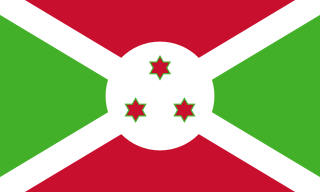Human occupation of Rwanda is thought to have begun shortly after the last ice age. By the 11th century, the inhabitants had organized into a number of kingdoms. In the 19th century, Mwami (king) Rwabugiri of the Kingdom of Rwanda conducted a decades-long process of military conquest and administrative consolidation that resulted in the kingdom coming to control most of what is now Rwanda. The colonial powers, Germany and Belgium, allied with the Rwandan court.
The Hutu, also known as the Abahutu, are a Bantu ethnic group which is native to the African Great Lakes region. They mainly live in Rwanda, Burundi, and Uganda where they form one of the principal ethnic groups alongside the Tutsi and the Great Lakes Twa.

The Burundian Civil War was a civil war in Burundi lasting from 1993 to 2005. The civil war was the result of longstanding ethnic divisions between the Hutu and the Tutsi ethnic groups. The conflict began following the first multi-party elections in the country since its independence from Belgium in 1962, and is seen as formally ending with the swearing-in of President Pierre Nkurunziza in August 2005. Children were widely used by both sides in the war. The estimated death toll stands at 300,000.

The New Partnership for Africa's Development E-School Program is included as a means to provide ICT equipment such as computers and internet access to all schools in member nations within The New Partnership for Africa's Development (NEPAD) program. NEPAD parents the E-School Program and is an economic program that aims to bring economic and social development to African nations and ensure 'Africa's Renewal'. The E-School Program began with Demonstration Projects and has developed further yet remains a work in progress in many countries, facing both criticism and support.
The Groupe Scolaire Officiel de Butare (GSOB) Indatwa n’inkesha, also known as the Indatwa n'Inkesha School, is a historic secondary school in Huye District in Butare, Rwanda. As well as being the oldest secondary school in the country, it is regarded as one of the most prestigious and successful public schools in Rwanda.

The African Peer Review Mechanism (APRM) is a mutually agreed instrument voluntarily acceded to by the member states of the African Union (AU) as a self-monitoring mechanism. The APRM was launched on 9 March 2003 by the NEPAD Heads of State and Government Implementation Committee (HSGIC) in Abuja, Nigeria (NEPAD/HSGIC/03-2003/APRM/MOU, Assembly Decision 198, Decision 527 and Decision Ext/Assembly/AU/Dec.1-4 ;

The International Scout and Guide Fellowship (ISGF) is a worldwide organization of adults in support of Scouting and Guiding.

The Bank of the Republic of Burundi is the central bank of Burundi. The bank was established in 1966 and its offices are in Bujumbura.

The Tanzania national rugby union team represents Tanzania in international rugby union. They are known as the Twigas. Tanzania is a member of the International Rugby Board.

On the evening of 6 April 1994, the aircraft carrying Rwandan president Juvénal Habyarimana and Burundian president Cyprien Ntaryamira, both Hutu, was shot down with surface-to-air missiles as their jet prepared to land in Kigali, Rwanda; both were killed. The assassination set in motion the Rwandan genocide, one of the bloodiest events of the late 20th century.
There are several planned railway lines in Rwanda, including a line to Tanzania. Historical railways are limited to three industrial railways.

Burundi, officially the Republic of Burundi, is a landlocked country in the Great Rift Valley at the junction between the African Great Lakes region and Southeast Africa, with population of over 14 million people. It is bordered by Rwanda to the north, Tanzania to the east and southeast, and the Democratic Republic of the Congo to the west; Lake Tanganyika lies along its southwestern border. The capital city is Gitega and the largest city is Bujumbura.
Rugby union in Burundi is a minor but growing sport.

Jean-Claude Iranzi is a Rwandan professional footballer who most recently played for Rwanda Premier League club Rayon Sports.

Claver Gatete is a Rwandan politician and diplomat who has been serving as the Executive Secretary of the United Nations Economic Commission for Africa since 2023.

Anne S. Casper is an American diplomat who served as United States Ambassador to Burundi from 2016 to 2019.

The Ikiza, or the Ubwicanyi (Killings), was a series of mass killings—often characterised as a genocide—which were committed in Burundi in 1972 by the Tutsi-dominated army and government, primarily against educated and elite Hutus who lived in the country. Conservative estimates place the death toll of the event between 100,000 and 150,000 killed, while some estimates of the death toll go as high as 300,000.

On 21 October 1993, a coup was attempted in Burundi by a Tutsi–dominated army faction. The coup attempt resulted in assassination of Hutu President Melchior Ndadaye and the deaths of other officials in the constitutional line of presidential succession. François Ngeze was presented as the new President of Burundi by the army, but the coup failed under domestic and international pressure, leaving Prime Minister Sylvie Kinigi in charge of the government.
The Akanyaru Multipurpose Dam, is a planned dam across the Akanyaru River, at the international border between Rwanda and Burundi. The dam will create a reservoir with storage capacity of 333,000,000 cubic metres (1.1759784018×1010 cu ft). The water is expected to supply drinking water to an estimated 614,200 people in both countries. The reservoir is also expected to provide irrigation water to an estimated 12,474 hectares (30,820 acres) of agricultural land in Burundi and Rwanda, benefitting an estimated 24,948 farmers. The dam will also host Akanyaru Hydroelectric Power Station, with generating capacity of 14.5 MW (19,400 hp).











